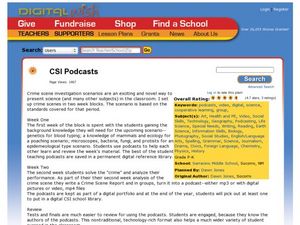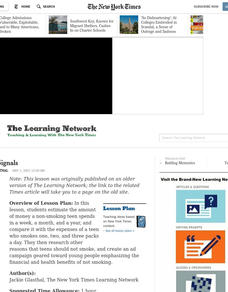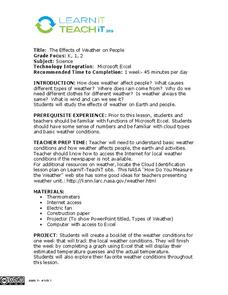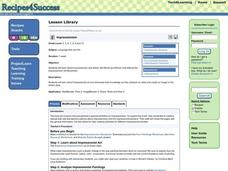Curated OER
Alphabetize For A Reason
Students organize information by using the alphabet. Students organize materials alphabetically. Students alphabetize with the first, second and third letters of a set of words. Students discover applications for alphabetical order.
Curated OER
Children's Literature Across the Curriculum Ideas
You can keep this printable idea sheet and use when you're in a tight spot. It contains cross-curricular ideas that span every subject while relating to the African tale, "Anasazi the Spider." Learners will act, write, move, count,...
Curated OER
Cameras and Careers
Applying photography basics they learn for this project, first graders take pictures of an adult at work focusing on the tools used, the work site, and job responsibilities. After making a career book that includes photos and...
Curated OER
Animal Self-portrait Mosaics: A Visual Arts Elective
Out-lined here is a two-week procedure that has the class creating ceramic animal tiles that are metaphorical representations of their own personalities. They discuss animal images found throughout history, what they mean, metaphor, and...
Curated OER
Judging a Book by Its Cover
Here's one of the very few lessons I've seen that works for everyone: kindergartners through college students! Readers of any age pick out a book from the class library or the school library, that has a damaged cover or jacket. Pupils...
Curated OER
CSI Podcasts
Students investigate crime scene scenarios to meet standards. In this crime scene scenario lesson, students gather background information during the first week. They investigate topics such as mammals, genetics, bacteria, or fungi. They...
Curated OER
Smoke Signals
Students estimate the amount of money a non-smoking teen spends in a week, a month, and a year, and compare it with the expenses of a teen who smokes one, two, and three packs a day. They research other reasons that teens should not smoke.
Curated OER
The Effects of Weather on People
Students discover the causes of different types of weather and it's effect on society. In this environmental lesson plan, students utilize the Internet to examine cloud types, normal weather conditions and the type of weather...
Curated OER
Quilting
First graders investigate the color spectrum by painting their own pictures. In this artistic expression lesson, 1st graders discuss their own families and create ways to express their culture and family history on a picture quilt....
Curated OER
Comparison/Contrast Composer Study
Pupils choose two composers to research and complete a compare and contrast study of them. In this composer research lesson plan, students select two composers to research. Pupils use Internet sources, the library, and music class...
Curated OER
OLYMPIC SHADOW BOXES
Pupils, in groups, use library reference materials to research an Olympic sport and create a visual display/shadow box to represent it.
Thirteen Ed Online
What is Conceptual Art?
Research, art history, and web page creation! Sounds too good to be true. With tons of links and resources, the lesson plan provides you with everything needed to engage the class in an amazing art and research activity. They create...
Curated OER
Guess Who's Coming to Our Classroom
Students use their research skills to determine the famous person given in clues. Using a character recently dicussed in their classroom, they discuss how they would create a costume for them. They write sentences to be used as dialogue...
Curated OER
People and Their Place in the Community
Third graders search TDC database for images of famous people, such as Rosa Parks, Gandhi, Martin Luther King Jr., etc. They also retrieve information about their accomplishments, time frames, areas, and how they made a difference in...
Curated OER
Appalachia
Students investigate the benefits of dance and participate in dances. In this dance lesson, students investigate a number of dances such as square dancing and clogging that are native to Appalachia. They use math concepts to determine...
Curated OER
My Favorite Story
Students discuss their favorite book. In this book discussion lesson, students name the title and tell what makes the book special. Students also review the setting, plot, conflict, and resolution. Students make a book that tells all of...
Curated OER
Kudos by Kiddos
Young scholars explore types of awards for children's books. They design a new award. Students review books and select one to receive the newly designed award. Young scholars create a "medal" for the book jacket. They write an...
Curated OER
LA CENERENTOLA (Cinderella)
Students research Cinderella stories from different cultures. They explore how words, like opera, can tell a story. Students identify the unique cultural elements of various versions of the Cinderella story. identify aspects of Students...
Curated OER
The Trial of Iago: "To you...remains the censure of this hellish villain"
Students analyze text and utilize outside resources to determine Iago's fate, which is not addressed by Shakespeare in Othello; students present their findings in an organized trial scenario.
Curated OER
Getting to Know Our School
Students explore their school and the various types of people who work there (school nurse, custodian, and principal). They interview these people and complete an activity based on the information they have obtained.
Curated OER
Impressionism
Students explore and discuss Impressionism and artists, like Monet and Renoir, who defined the Impressionism Art Movement, choose an artist to research, and create web sites based on their research.
Curated OER
Me: A Visual Essay
Students familiarize themselves with photo editing and montage techniques. They create a montage that tells the viewer about themselves.
Curated OER
You've Got Rhythm
Students study the rhythm value of a half note, quarter note, whole note, and eighth note. They stamp a rhythm pattern and create a clay animation which demonstrates note value.
Curated OER
Song Dynasty Traditional Landscape Paintings
Students study new ideas and art concepts, while reinforcing others, through a Chinese cultural tradition. They determine how cultural differences differences affect painting processes.























